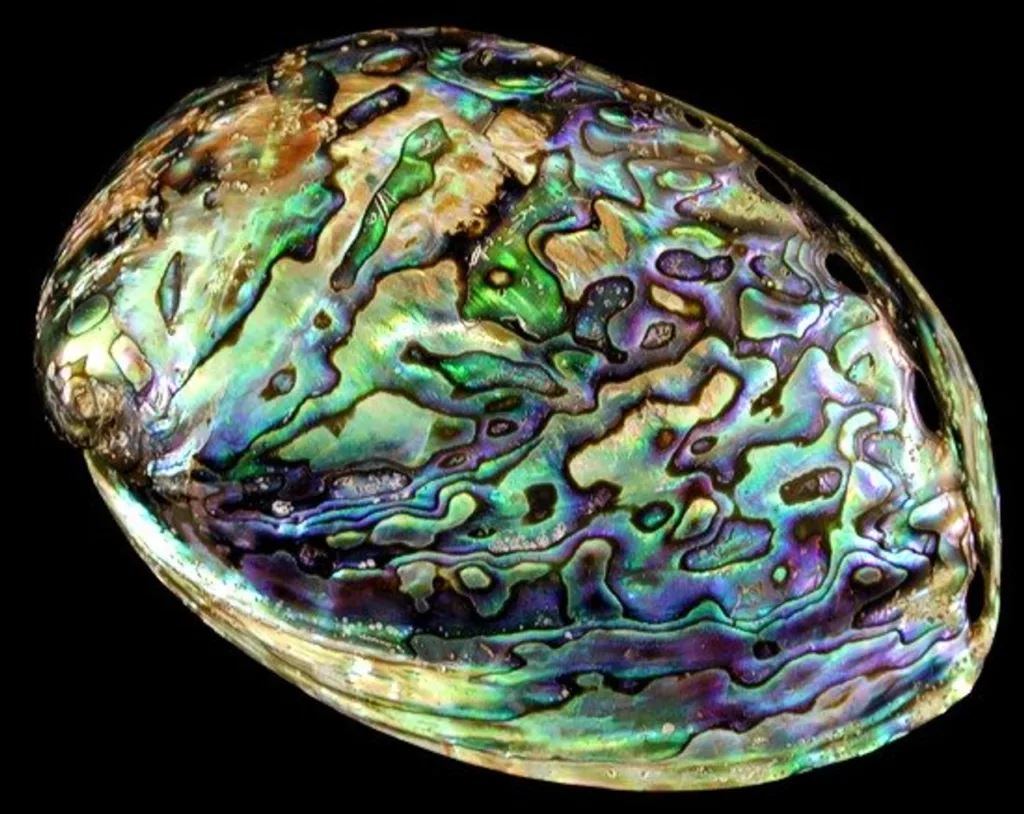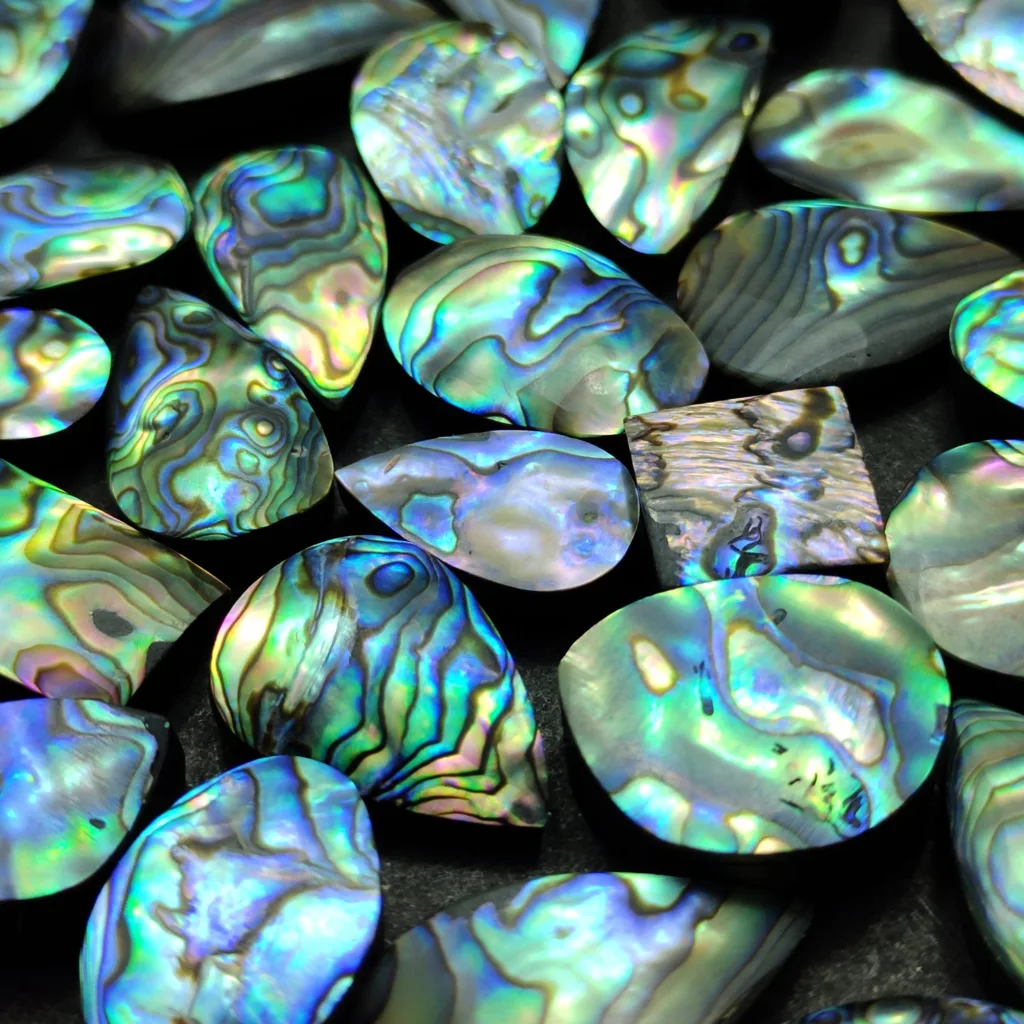Abalone is not typically considered a gemstone; rather, it is a marine mollusk known for its iridescent and colorful shell. The term “abalone” refers to a group of large sea snails, specifically those in the Haliotidae family. These mollusks are often prized for the vibrant and captivating mother-of-pearl lining found on the inside of their shells.

Definition and Overview: Abalone shells are characterized by their unique and iridescent appearance, displaying a range of colors such as blue, green, pink, and purple. The play of colors is a result of the shell’s nacre, which is the same substance that forms pearls. The outer layer of the shell is typically dull and rough, providing protection for the mollusk. The inner layer, however, is highly prized for its beauty.
While not a gemstone in the traditional sense, abalone shell is frequently used in jewelry and decorative arts. Slices of abalone shell are often incorporated into jewelry pieces such as earrings, pendants, and inlay work in various cultures around the world.
Historical Use and Cultural Significance: Abalone has a rich history of use in various cultures, particularly among indigenous peoples. Native American tribes, such as the Haida, Tlingit, and Kwakiutl, have traditionally used abalone shells in the creation of intricate carvings, masks, and other ceremonial items. The shell is valued not only for its aesthetic appeal but also for its spiritual significance.
In Native American traditions, abalone shell is believed to carry positive energies and is often used as a vessel for holding and burning sage or other sacred herbs during spiritual ceremonies. The iridescence of the shell is thought to represent the ever-changing nature of life.
In addition to Native American cultures, abalone has been historically significant in various other societies. For example, in Chinese culture, abalone is considered a symbol of good fortune and prosperity. In Japan, the inner surface of abalone shells has been used for centuries to create intricate inlays in lacquerware, adding a touch of elegance to traditional art pieces.
While abalone is not a gemstone per se, its historical use and cultural significance make it a unique and cherished material in the realm of decorative arts and jewelry, appreciated for its beauty and symbolism across different civilizations.
Characteristics of Abalone

Abalone, as a marine mollusk, exhibits several distinctive characteristics that contribute to its unique appeal and value. Here are some key characteristics of abalone:
- Iridescent Shell: The most notable feature of abalone is its iridescent shell. The inner layer of the shell, also known as nacre, displays a stunning array of colors, including blues, greens, pinks, and purples. This iridescence is a result of light interacting with the layers of aragonite crystals and organic material in the shell.
- Shell Structure: Abalone shells have a distinctive structure characterized by a series of small, overlapping tiles or ear-shaped holes. These holes allow the mollusk to breathe and expel waste. The outer surface of the shell is generally rough and coarse, providing protection from predators.
- Mother-of-Pearl: The inner layer of the abalone shell is composed of mother-of-pearl, which is the same substance that forms pearls. Mother-of-pearl is valued for its smooth, lustrous appearance and is often used in jewelry and decorative arts.
- Size and Shape: Abalones come in various sizes, with some species growing larger than others. They typically have a flattened, ear-shaped or oval form. The size and shape can vary among different species and geographical locations.
- Habitat: Abalones are found in rocky coastal areas around the world. They adhere to rocks using a powerful foot and are often found in intertidal zones. The specific species of abalone may inhabit different regions, and their distribution can be influenced by factors such as water temperature and food availability.
- Diet: Abalones are herbivores, primarily feeding on algae and other plant matter. Their radula, a specialized feeding organ, allows them to scrape algae off rocks.
- Slow Growth: Abalones are known for their slow growth rates. It may take several years for them to reach maturity, and their growth is influenced by factors such as environmental conditions and available food sources.
- Cultural and Spiritual Significance: Beyond its biological characteristics, abalone holds cultural and spiritual significance in various societies. It has been used in the creation of traditional art, jewelry, and ceremonial items, symbolizing aspects such as beauty, spirituality, and abundance.
While abalone is not a gemstone in the traditional sense, its unique characteristics, especially the iridescent shell and cultural significance, contribute to its popularity in the realms of art, jewelry, and spirituality.
Geographical Distribution

Abalones are found in various coastal regions around the world, particularly in temperate and warmer waters. The distribution of abalones is influenced by factors such as water temperature, rocky substrate availability, and the presence of suitable food sources. Here are some key regions where abalones are commonly found:
- California, USA: The California red abalone (Haliotis rufescens) is native to the waters along the California coast, extending from the northern part of the state to Baja California in Mexico. California has been a significant region for abalone harvesting, although populations have declined due to overfishing and other environmental factors.
- South Africa: Abalones are found along the coasts of South Africa, where they are known as “perlemoen.” The South African abalone (Haliotis midae) is one of the most sought-after species in the region, and it has faced challenges due to illegal harvesting.
- Australia: The waters around Australia are home to various abalone species, including the greenlip abalone (Haliotis laevigata) and the blacklip abalone (Haliotis rubra). These species are commercially harvested for both domestic consumption and export.
- New Zealand: Abalones, locally known as pāua, are found along the coasts of New Zealand. The New Zealand pāua (Haliotis iris) is valued for its vibrant and colorful shell, and it is protected by regulations to prevent overharvesting.
- Japan: Abalones are present in the coastal waters of Japan, and they have cultural and culinary significance in Japanese cuisine. The Japanese abalone (Nordotis discus) is one of the species found in this region.
- Chile: Along the coast of Chile in South America, abalones are also found. The Chilean abalone (Concholepas concholepas) is one of the species found in this area.
- China and Southeast Asia: Various abalone species are distributed in the coastal waters of China and other Southeast Asian countries. Abalones are not only harvested for local consumption but also play a role in traditional Chinese medicine.
It’s important to note that the distribution of abalones can be influenced by environmental factors, and some species may be more prevalent in specific regions. Additionally, overharvesting, habitat destruction, and other human-related activities have led to declines in abalone populations in certain areas, prompting conservation efforts and regulations to protect these mollusks.
Uses of Abalone

Abalone is a versatile material that has been used for various purposes throughout history, valued for its iridescent shell and the mother-of-pearl lining. Here are some common uses of abalone:
- Jewelry: One of the most popular uses of abalone is in jewelry making. Slices of the colorful and iridescent inner shell are often incorporated into earrings, pendants, bracelets, and other accessories. The unique patterns and hues of the shell add a distinctive and eye-catching element to jewelry designs.
- Inlay Work: The mother-of-pearl lining of abalone shells is frequently used for intricate inlay work in woodworking, furniture, musical instruments, and decorative arts. The shells are carefully cut into shapes and embedded into surfaces to create beautiful and detailed patterns.
- Cultural and Ritual Items: Abalone shells hold cultural and spiritual significance in various societies. Indigenous peoples, especially in North America, have historically used abalone shells in the creation of ceremonial items such as masks, headdresses, and regalia. The shells are often considered sacred and are used in rituals and spiritual ceremonies.
- Smudging Bowls: In Native American and other spiritual traditions, abalone shells are used as smudging bowls. They are used to hold and burn sage, palo santo, or other sacred herbs during purification and cleansing ceremonies. The iridescence of the shell is believed to enhance the spiritual energy of the ritual.
- Culinary Delicacy: The meat of abalones is considered a delicacy in many cultures, particularly in East Asian cuisines. Abalone is often consumed raw, dried, or cooked in various dishes such as soups, stir-fries, and sashimi.
- Traditional Medicine: In some traditional Chinese medicine practices, powdered abalone shell has been used for its perceived health benefits. It is believed to have properties that promote skin health and vitality.
- Pearl Farming: While abalone itself does not produce pearls, the inner shell lining, known as nacre or mother-of-pearl, is similar to the substance that forms pearls. In some cases, abalone shells have been used as a substrate in pearl farming to produce cultured pearls with unique colors and luster.
- Handicrafts and Ornaments: The colorful and durable nature of abalone shells makes them suitable for a variety of handicrafts and ornamental items. These can include decorative boxes, buttons, and other small objects where the iridescence of the shell enhances the visual appeal.
It’s important to note that the harvesting of abalone is regulated in many regions due to concerns about overexploitation and conservation. Conservation efforts are underway to protect abalone populations and ensure their sustainable use in various industries.




































